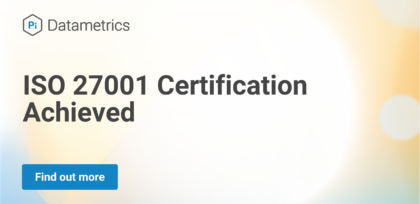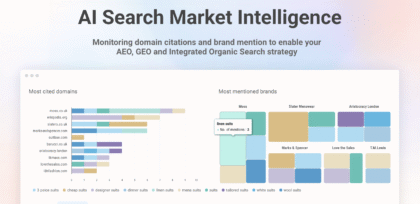Developments in SEO and semantic search
08 Mar 2017|4 MIN READ
Last month I gave a talk at the Independent Publishers' Guild Spring Conference titled Smart Search: How to apply search engine data in publishing.
Based on that talk, here are some thoughts on:
- Where SEO is today
- Where it's going
- What we can learn from it
- How to apply it
20 years of Google Search
Google Search is 20 years old, more or less. We can disagree about when exactly we regard as the beginning. What’s important is this: there are a lot of people out there who’ve never known a world without the internet. They’re our colleagues and customers. You might even be one of them.
Obvious, yes. But so much so, that it's easy to overlook what an important cultural divide this is. While preparing my talk, I had a typically wide-ranging and tangential conversation with our CTO, Jon Earnshaw. Having both begun our digital careers around the early noughties, we spent much of an afternoon reminiscing about building static HTML websites in an era of 56Kbps dial-up, omnipresent AOL trial CDs and website guestbooks. Less than two decades have passed since then, but already it sounds amusingly quaint and antiquated.
A timeline of Google developments and innovation
Looking at a selection of major developments in Google over just the last 10 years, we can quickly see an incredible rate of innovation and change.
But where is all this leading to? Highlighting a few key developments, we see a clear trend:
Semantic search developments
Mobile voice search
The arrival of voice search for mobile in 2009 laid foundations for freeing us from our keyboards, and the constraints they impose on how we form search queries. Not only that, the rise of smartphones around the same time alters the context of search. We're no longer forced to search from a computer at a desk; we can do it almost anywhere, at any time, even while doing something else.
Hummingbird and Knowledge Graph
Knowledge Graph brings a further critical development: the ability for Google to understand and work with real-world entities and the relationships between them. A major step forward from matching search strings to words in documents, this brings us closer to truly intelligent search. Shortly afterwards, the Hummingbird update brings more sophisticated language processing, including improved handling of semantics and 'conversational' search terms.
RankBrain
Most recently, artificial intelligence has become a core part of Google's search algorithm: RankBrain, the 3rd most authoritative signal out of 200 major ranking signals. Again, for those of us of a certain vintage, it's all too easy to overlook the implications here.
Our AI watershed came when the then world chess champion, Gary Kasparov, lost to IBM's Deep Blue. But this was more a landmark in computational brawn than intelligence. Given the rules and history gameplay, it's a relatively simple matter for a powerful enough computer to win by calculating all possible outcomes for every move.
But now we've seen Google DeepMind's AlphaGo use real learning to win at Go, a much more abstract game with many more possible moves than chess. And we've seen AI win repeatedly and convincingly against highly skilled and experienced human fighter pilots. This is a different a different level of impressive.
Technological and cultural evolution supporting semantic search
What we're seeing is not only an evolution in search technology; we're participants in a major cultural shift. Search technology is taking a central and very influential role in how we interact with the real world. We use search every day to help us make real decisions: where to go, when to go, and what to do when to get there.
In short, the division between our digital and offline lives is increasingly blurred, and we're at the beginning of a cycle of mutual influence. Our needs shape search, and search is shaping how we meet our needs. With the power of real machine learning and an increasingly tech-dependent populace, we're only going to see an accelerating rate of change.
Rethinking strategy for semantic search
And here’s where the cultural shift gets even more interesting. Computers, as we've always known them, essentially replicate a filing cabinet: a dumb arrangement of folders and files, navigated by memory, intuition, trial and error searches for identifying strings of words. The internet is an extension of the same idea and, to navigate, we’ve learned to play what Jon Earnshaw calls a 'keyword game'. We form keyword searches, so we build and optimize content around keywords.
But computers and search engines are beginning to 'think' like us, and interact with us on our terms. Consider the complexity behind answering a simple voice query: "Who was the Prime Minister during World War 1?"
Superficially, it's a very simple construction, but answering it – regardless of reaching the correct answer – entails a long chain of fairly sophisticated thought.
Voice search in action
Already, Google reports that 20% of searches on mobile are voice searches. However, Google also reports that, while 57% of teens use voice search around friends, only 24% of adults do. Here again is evidence of a cultural shift. Teens are confident using voice search around their friends, suggesting they feel natural and comfortable with it. Adults meanwhile are more private and self-conscious.
This suggests that, at least for a while, we will need to find ways to optimize websites for both camps. But is that possible?
Winning and losing at the keyword game
We can already see the impact of this shift toward voice and conversational searches in our data from the Pi Platform. In the examples below, we see how sites can perform well for old 'keyword game' searches, while failing to perform at all for their conversational equivalents. Likewise, we see the exact reverse.

Ranking well for keyword-based search queries

Ranking well for conversational search queries
Leveraging data for better business decisions
This evolution isn’t limited to how we find and interact with information; it’s changing how we make creative decisions of all kinds.
Take Netflix, for example. Their first piece of original content was commissioned in 2011. For context, bear in mind that Netflix only launched as a streaming service 4 years earlier and had yet to launch outside the United States. There was a lot riding on the success of that show, and yet:
- They hired a big-name, Oscar-nominated Hollywood director and an Oscar-winning, Hollywood, A-lister actor
- They chose a sophisticated and dense political drama; not what most people would call a surefire hit
- They broke with decades old TV tradition, foregoing a pilot episode and instead committing to two full series up-front
- And all this at upwards of an estimated $3.8 million per episode
As you almost certainly know, House of Cards went on to be something of a success and Netflix, now operating in almost every market in the world, produces more original content than any other American TV channel. Spectacularly well-judged punt, or is something else at work?
Of course, Netflix weren't just guessing. Their Chief Content Officer, Ted Sarandos, had looked at their customers' streaming data and established exactly what they liked, and how they consumed it. And this power is available to us all; from Google Trends, to web analytics, to our own SEO platform, Pi Datametrics.
Adapting content creation for the future of search
It's time to abandon our attachment to keywords and start thinking and creating like humans again. In creating content, we need to think about topics, people, things, experiences, relationships, problems, solutions, and the conversations they inspire. Good technology, mature technology, is transparent. It becomes truly integrated into our lives. It is adapted to us rather than we to it, and we interact with it as naturally as we interact with each other.
In much the same way, effective content is transparent and adapted to the needs of people, not software. In turn, the better our software gets, the better we're able to really understand and adapt to the needs of the audiences we strive to reach.
If you want to discuss your content strategy with Glynn Davies, don't hesitate to get in touch. He'll help you prepare for further advances in deep learning, so that you're well placed within your market(s) to benefit from semantic search.
Want more? Read our cannibalisation studies:
Never miss a post
Join our mailing list and have our SEO news delivered straight to your inbox.










